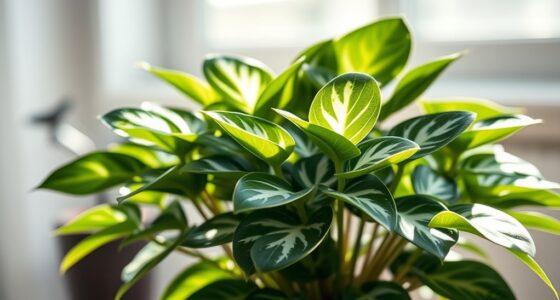To care for your aloe vera, give it bright, indirect sunlight for 8-10 hours daily, either near south or west windows indoors or in sunny outdoor spots. Water sparingly, allowing the soil to dry completely between watering—about every 7-14 days in summer and much less in winter. Use well-draining soil, protect your plant from frost, and remember to harvest and safely use the gel from mature leaves. If you continue, you’ll discover more tips for keeping your aloe healthy and thriving.
Key Takeaways
- Provide bright, indirect sunlight for 8-10 hours daily, placing indoors near south or west-facing windows.
- Water sparingly, allowing soil to dry completely between watering; reduce frequency during winter dormancy.
- Use well-draining soil like cactus mix with sand or perlite, and ensure containers have drainage holes.
- Protect outdoor plants from frost; bring indoors when temperatures drop below 40°F, and maintain warmth during winter.
- Harvest gel from mature leaves carefully, and use for skincare, burns, and cosmetic purposes; keep out of reach of pets and children.
Optimal Sunlight Conditions for Aloe Vera
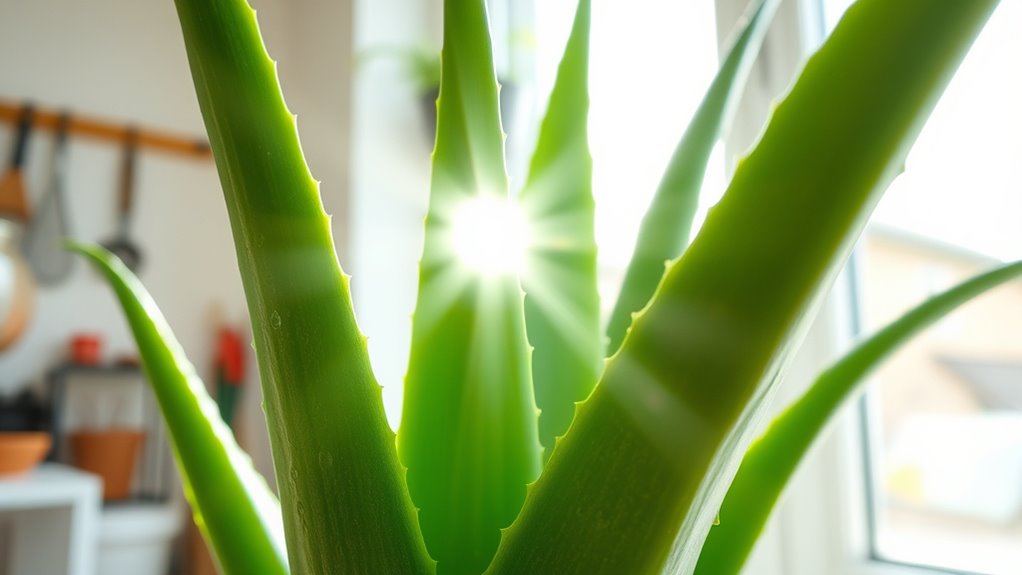
Aloe Vera plants need plenty of bright, indirect sunlight to grow healthy and strong. To grow aloe vera successfully, aim for about 8 to 10 hours of sunlight exposure daily. Incorporating adequate lighting conditions can significantly influence the plant’s growth and overall health. Outdoors, you can place your aloe where it receives bright light, but avoid harsh, direct hot sun that can scorch the leaves—filtering the sunlight or providing partial shade helps. If you’re growing indoor lighting, position your plant near a south or west-facing window to ensure it gets enough light. While outdoor aloe thrives with ample sun, indoor aloe needs proper placement to prevent drooping and leaf damage caused by insufficient light.
Proper Watering Techniques and Schedules

To keep your aloe vera healthy, maintaining proper watering and following a consistent schedule is vital. Check soil moisture deeply with your finger or a moisture meter before watering to prevent overwatering. Using a watering can with a narrow spout helps to water evenly around the plant’s base. Typically, water every 7-14 days in summer and about once every two months in winter, adjusting based on your environment. Use proper watering techniques by watering evenly around the plant’s base, ensuring excess water drains freely through drainage holes to avoid root rot. Shallow watering can harm your plant, so water thoroughly to moisten the entire root zone. Remember, overwatering causes leaves to wilt, yellow, and may lead to root rot. Let the soil dry out completely between watering sessions to promote healthy growth and avoid common issues. Additionally, choosing a container with proper drainage is essential for optimal aloe vera health. Proper watering practices also help prevent common problems like root rot and other moisture-related issues. Incorporating knowledge about AI integration in smart devices can help in monitoring and maintaining optimal watering conditions with smart sensors.
Ideal Soil Types and Drainage Tips
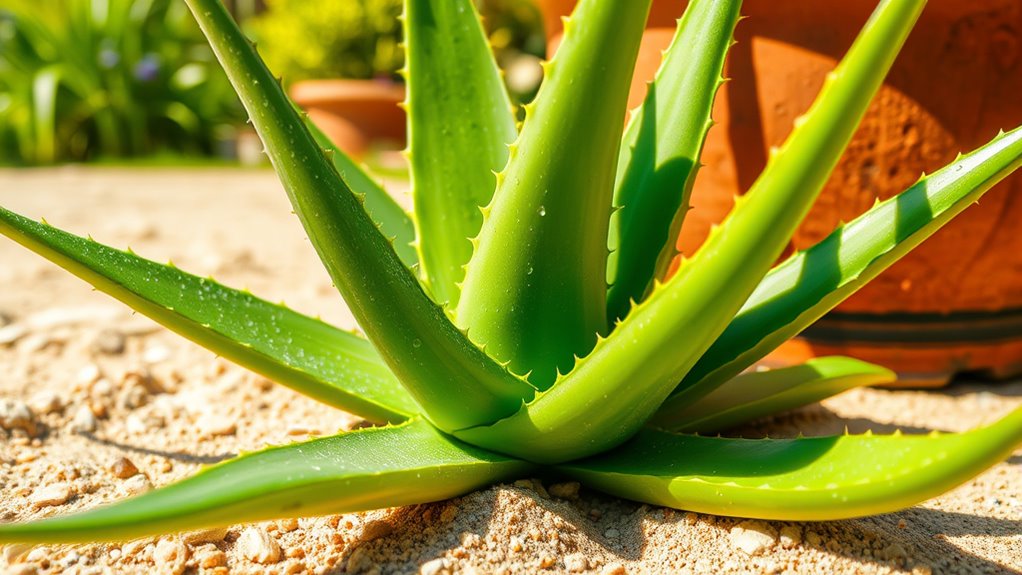
Choosing the right soil is key to keeping your aloe vera healthy and thriving. You should use well-draining soil, such as a succulent mix containing sand, perlite, or coarse gravel, to guarantee proper drainage. Avoid heavy, water-retentive soils like garden soil or clay, which can cause root rot by trapping moisture around the roots. The soil pH should be slightly acidic to neutral, ideally between 6.0 and 7.0, to promote healthy root development. When repotting, always select a container with drainage holes and fill it with a porous, well-draining mix to prevent excess moisture. Proper soil and drainage help mimic your aloe vera’s native desert environment, supporting strong, healthy growth and reducing the risk of problems. Ensuring your soil is free of excess moisture is also crucial for preventing overwatering issues. Using a drainage-enhanced soil can further improve aeration and drainage for your plant. Additionally, selecting appropriate soil types tailored for succulents can boost your plant’s resilience and overall health. Regularly checking soil moisture levels can help you avoid overwatering and keep your aloe thriving.
Temperature Ranges and Overwintering Practices
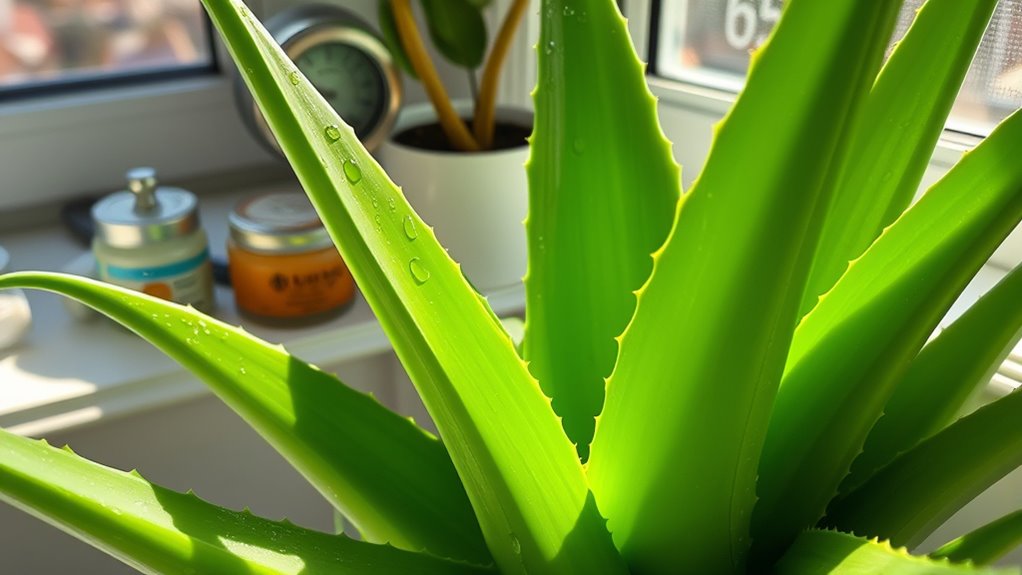
Knowing the right temperature range is essential for keeping your aloe vera healthy. It can usually handle temperatures between 55°F and 80°F. However, it needs protection below 40°F to avoid damage. When winter approaches, you’ll need to take specific indoor steps to guarantee your plant survives the cold. Proper temperature regulation is crucial for maintaining the health of your aloe vera during colder months. Additionally, understanding overwintering practices can help prevent stress and ensure your plant’s longevity. Ensuring adequate light exposure during the winter months also supports your plant’s health and growth. Maintaining consistent humidity levels is also important, especially when indoors, to prevent the plant from drying out. Proper watering techniques also contribute significantly to the plant’s overall health during seasonal changes.
Cold Tolerance Limits
Aloe Vera plants can withstand temperatures as low as 28°F (-2°C), but they start to suffer cold stress below 40°F (4°C). Understanding their cold tolerance is key to winter care. When outdoor temperatures drop below 50°F (10°C), you should provide frost protection, like covers, or move your Aloe Vera indoors. Proper winter care involves monitoring temperatures closely and adjusting your overwintering strategies accordingly to prevent cold damage. Prolonged exposure to freezing temperatures can damage or kill the plant, so in colder climates, it’s best to bring the plant inside or into a greenhouse before temperatures approach freezing. If you want to keep outdoor Aloe Vera thriving through winter, ensure it’s protected from frost and cold stress. Enhancing cold tolerance through proper care can help your Aloe Vera better withstand low temperatures, especially when combined with other climate considerations that affect its health. Additionally, ensuring the plant is kept away from drafty areas can further reduce cold stress and promote healthier growth during winter months.
Overwintering Indoor Strategies
During winter, maintaining the right indoor temperature is essential to keep your Aloe Vera healthy. For effective indoor winter care, guarantee indoor temperatures stay above 40°F to prevent cold damage. When overwintering aloe vera, keep it away from drafts and cold windows, especially if outdoor temperatures fall below 55°F. Place your plant near a south or west-facing window to maximize indoor light during shorter days. Reduce winter watering to about once every two months, as the plant enters dormancy and needs less moisture. Proper light management and temperature control are crucial for keeping your Aloe Vera thriving indoors during the colder months. Additionally, ensuring proper soil drainage helps prevent root rot during periods of reduced watering. Proper temperature regulation is vital to prevent stress and maintain plant health during colder seasons. Protect outdoor plants from frost by bringing them inside or covering them. Proper frost protection and temperature management help your Aloe Vera thrive indoors, ensuring it remains healthy and vibrant throughout the colder months. Maintaining optimal humidity levels can also support your plant’s overall health during winter.
Fertilization Recommendations for Healthy Growth

To promote healthy growth, aloe vera plants need only minimal fertilization. Use a balanced, diluted fertilizer sparingly during the active growing seasons in spring and early summer. Applying a half-strength fertilizer once or twice a year provides essential nutrients without risking overfeeding. A top dressing of worm castings or slow-release cactus fertilizer in spring can support growth naturally. Be cautious with watering and fertilization during winter dormancy—reduce or stop feeding altogether to prevent stress or nutrient buildup. Commercial aloe-specific fertilizers are available, but a simple, diluted houseplant fertilizer or compost tea usually supplies enough nutrients for *ideal* health. Remember, over-fertilizing can cause weak growth and root damage, so less is more when it comes to maintaining a healthy aloe vera plant. Additionally, since aloe vera prefers well-draining soil and minimal nutrients, over-fertilizing may lead to weak growth and root damage. Understanding plant nutrient requirements helps prevent common issues associated with overfeeding.
Propagation Methods Using Offsets and Pups
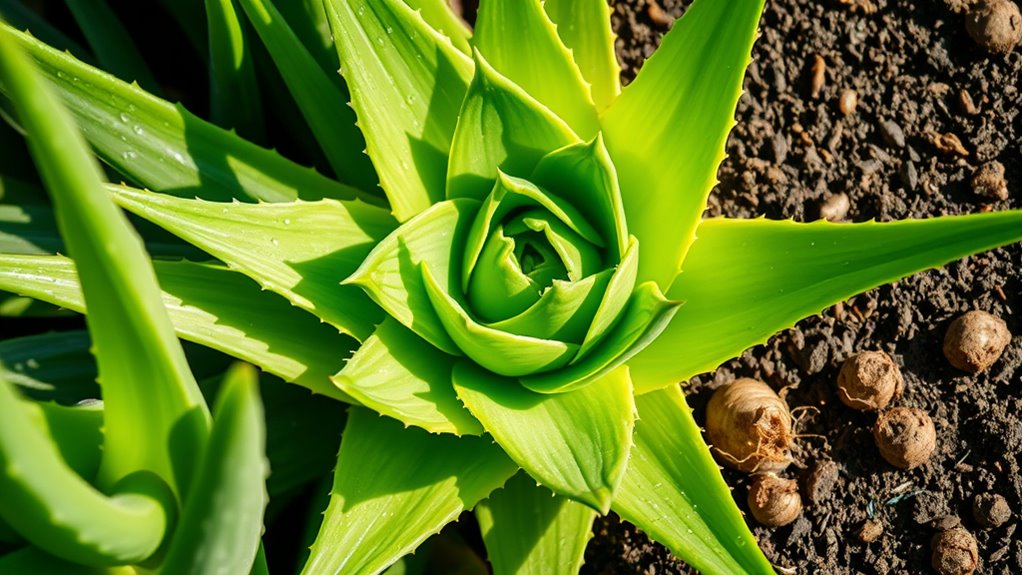
When propagating aloe vera using offsets, choose healthy pups with strong roots to guarantee successful growth. Carefully separate them from the parent plant using proper replanting techniques, and let the cuts callus over before planting. Additionally, ensuring proper greenhouse conditions can promote healthy root development and plant vigor. Using diverse designs in planters can also provide better drainage and aeration for the new plants.
Selecting Healthy Offsets
Selecting healthy offsets is essential for successful aloe vera propagation. Look for pups with firm, plump leaves that are free from discoloration, pests, or damage.
Make certain the offsets have developed their own root systems before detaching by checking for new roots or a stable base. Healthy pups will have a well-established root system, making propagation more likely to succeed.
Use clean, sharp tools to gently detach the offsets from the main plant, cutting at the base close to the mother to minimize damage.
After detaching, allow the pups to callus for a few days in a dry, shaded area, which helps prevent rot.
Proper selection of offsets sets the foundation for thriving new plants and a successful propagation process.
Proper Replanting Technique
After choosing healthy offsets, the next step is to replant them properly to guarantee successful growth. Carefully remove the pups during pup separation using clean tools to avoid damage. Let the cut or separated pup callus over for a few days; this step is essential to prevent rot. When you’re ready, plant the pup in well-draining soil, such as cactus or succulent mix, to promote healthy growth. Water sparingly until the pup establishes roots. Proper replanting technique ensures your Aloe vera develops strong roots and remains vibrant. Use this table as a quick guide:
| Step | Action | Tips |
|---|---|---|
| Pup separation | Gently detach pups | Use clean, sharp tools |
| Callus over | Let cut callus over for days | Prevent rot |
| Planting Aloe vera | Replant in well-draining soil | Water sparingly |
| Establish roots | Keep soil moist temporarily | Ensure healthy growth |
| Monitor growth | Observe for new leaves | Maintain vitality |
Pruning and Maintenance to Promote Longevity
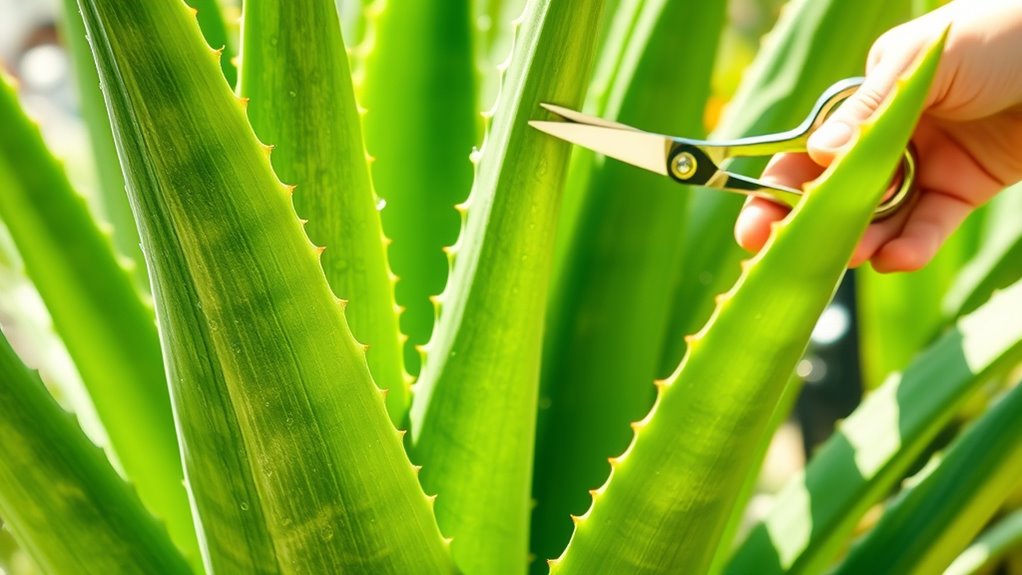
Regular pruning is essential for maintaining your aloe vera’s health and appearance. Proper maintenance removes dead leaves and spent flower stalks, encouraging healthy growth and preventing disease.
Use clean, sharp shears to carefully trim damaged or brown leaves close to the base—this won’t harm the plant. After blooming, remove old flower stalks to prevent energy from being wasted on seed production and to promote new blooms.
Pruning also helps control the plant’s size and shape, especially in containers or decorative settings. Keep these tips in mind:
- Remove dead or dying foliage near the base
- Cut back spent flower stalks after flowering
- Use sterilized tools for clean cuts
- Regularly maintain to ensure plant longevity and vigorous growth
Harvesting and Using Aloe Vera Gel Safely
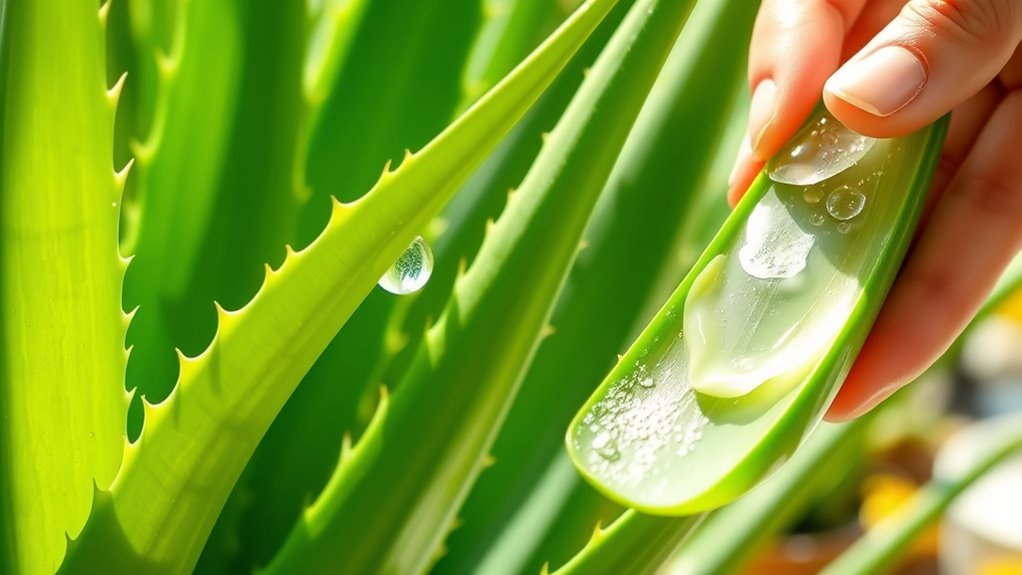
To harvest aloe vera gel safely, start by choosing a healthy, mature leaf near the plant’s base and cut it close to the stem with a clean, sharp knife.
Allow the cut leaf to drain latex, a yellowish sap that can cause skin irritation, by letting it sit upright for 10-15 minutes. Rinse the leaf thoroughly to remove any residual latex, then carefully peel away the spiky edges and outer skin.
This reveals the clear gel inside, which you should scoop out with a spoon or knife, avoiding discolored or brown parts that may indicate spoilage.
Store the fresh gel in an airtight container in the refrigerator and use within a week. Proper harvesting and storage help assure the gel’s safety and potency for skincare or other uses.
Common Pests and How to Manage Them
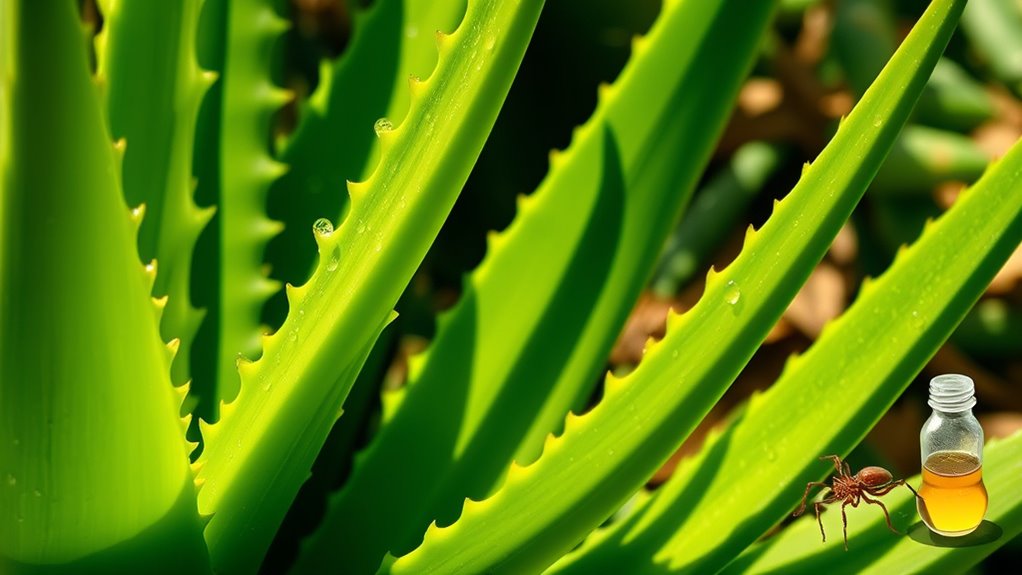
You need to be on the lookout for pests like orange aphids, mealy bugs, and scale insects that can harm your aloe vera. Spotting these pests early makes controlling them much easier, often with simple methods like sprays or manual removal.
Staying vigilant and keeping your plant healthy helps prevent infestations from taking hold.
Identifying Common Pests
Aloe vera plants can fall prey to several common pests that damage their leaves and stems, making early identification crucial for effective management.
Look for signs like small orange aphids on outdoor leaves, which can be rinsed away or treated with insecticidal soap.
Mealybugs appear as white, cottony masses on the plant’s surface and can be removed with alcohol-soaked cotton swabs or scraping.
Scale insects look like tiny brown or gray bumps and can be gently scraped off or managed with horticultural oil.
Regular inspection helps catch pest infestations early, preventing harm to your plant.
Recognizing these pests quickly is key to maintaining plant health and effective pest control.
Stay vigilant to keep your aloe vera thriving.
Effective Pest Control Methods
Effective pest control for aloe vera involves identifying common pests early and applying targeted management strategies. Pests such as orange aphids outdoors and mealybugs or scale insects indoors can cause leaf discoloration and plant stress.
To manage pests, gently remove them with a strong stream of water, alcohol-soaked cotton swabs, or a soft brush. Regularly inspecting leaves and stems helps detect infestations early, preventing widespread damage.
Using insecticidal soap or neem oil offers safe, effective pest control; reapplications may be needed for persistent issues. Maintaining proper watering practices and good airflow around your aloe vera discourages pests by avoiding overly moist or stagnant conditions.
Consistent pest management keeps your plant healthy and thriving.
Creative Ways to Incorporate Aloe Vera Into Your Space
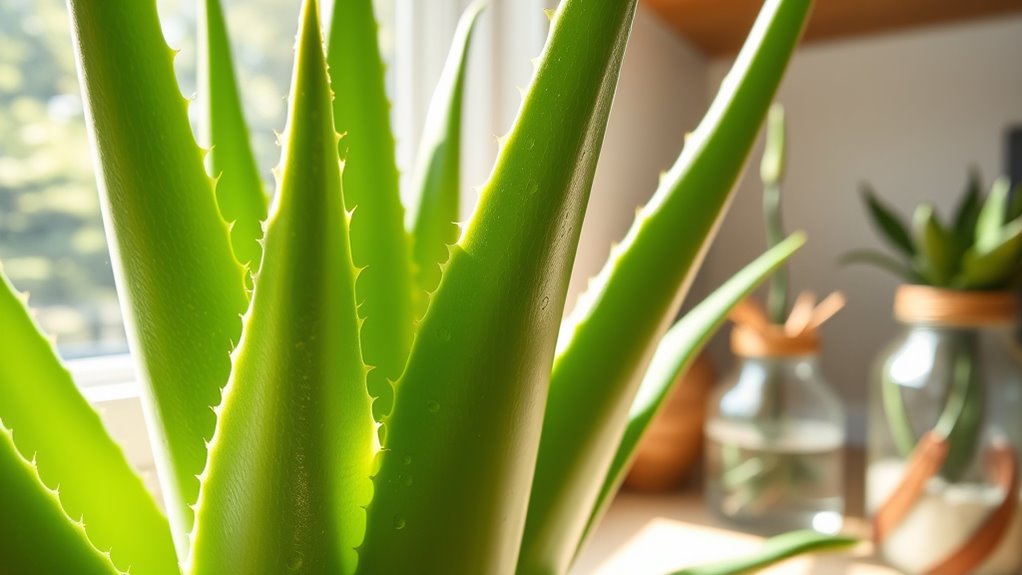
Integrating aloe vera into your home decor can be both stylish and functional, adding a touch of greenery while providing natural healing benefits. You can use the plant as a centerpiece on coffee tables or kitchen counters, making it accessible for harvesting gel and enhancing your decor.
Create a living wall or vertical garden with multiple aloe vera plants alongside other succulents to boost greenery and health benefits. For a unique touch, use aloe vera leaves as natural, biodegradable planters or decorate with twine and stones around their base.
Display aloe vera in transparent glass jars or terrariums to show off its rosette shape. These DIY ideas seamlessly blend plant decor with practical health benefits, transforming your space into a lush, healing environment.
Frequently Asked Questions
How Do I Make My Aloe Plant Happy?
To make your aloe plant happy, make sure it gets plenty of bright, indirect sunlight daily.
Water it only when the soil is completely dry, about every 2-4 weeks, to avoid overwatering.
Use well-draining soil, like cactus mix, and keep the temperature between 55°F and 80°F.
Regularly remove dead leaves and spent flower stalks to keep it healthy and pest-free.
Your aloe will thrive with these simple care steps.
How Do You Use Fresh Aloe Vera for Plants?
Think of your aloe vera as a silent healer waiting to share its magic. To use fresh aloe for your plants, pick a mature leaf and cut it near the base, letting the yellow latex drain. Rinse, trim spiky edges, and peel back the skin.
Scoop out the gel, dilute it with water, and spray onto leaves or soil. It’s like giving your plants a natural, nourishing boost from nature’s own pharmacy.
Where Is the Best Place to Put an Aloe Vera Plant in Your House?
You should place your aloe vera plant near a south or west-facing window indoors to get plenty of bright, indirect sunlight.
Avoid direct hot afternoon sun through the glass, which can burn the leaves.
If outdoors, find a spot with 2-3 hours of morning or late afternoon sun, protecting it from intense midday heat.
Keep it away from cold drafts and drafts below 55°F for healthy growth.
What Can Aloe Vera Be Used For?
Aloe vera is incredibly versatile. You can use its gel externally to soothe burns, cuts, and skin irritations thanks to its anti-inflammatory properties.
Internally, drinking aloe vera juice may help digestion and reduce acid reflux. It also benefits your skin by improving elasticity and reducing wrinkles.
In hair care, it hydrates your scalp and strengthens strands. Just be cautious with the latex, as it can be toxic in large amounts.
Conclusion
So, after all that fuss about sun, water, and soil, it turns out your aloe vera just needs a little love and attention—who knew? It’s almost funny how this hardy plant thrives with minimal care, yet we obsess over perfect conditions. So go ahead, forget the fuss, and enjoy your low-maintenance green companion. It’s the plant that proves sometimes, less really is more—ironic, isn’t it?



